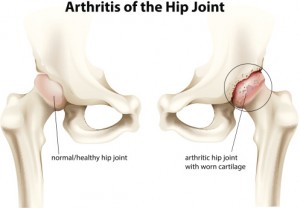

 Hip osteoarthritis can cause pain and may not be visible on x-ray. A new study has found that the majority of hip x-rays cannot detect hip osteoarthritis (OA), which can delay treatment of the disease. Hip osteoarthritis is a major cause of morbidity and leads to pain, difficulties walking, and even disability. The prevalence of hip osteoarthritis for those over the age of 60 has doubled in the past 30 years.
Hip osteoarthritis can cause pain and may not be visible on x-ray. A new study has found that the majority of hip x-rays cannot detect hip osteoarthritis (OA), which can delay treatment of the disease. Hip osteoarthritis is a major cause of morbidity and leads to pain, difficulties walking, and even disability. The prevalence of hip osteoarthritis for those over the age of 60 has doubled in the past 30 years.
Researchers looked at 4,500 participants from the Framingham Osteoarthritis and Osteoarthritis Initiative studies. Corresponding author, Dr. Chan Kim, said, “The majority of older subjects with high suspicion for clinical hip osteoarthritis did not have radiographic hip osteoarthritis, suggesting that many older persons with hip osteoarthritis might be missed if diagnosticians relied on hip radiographs to determine if hip pain was due to osteoarthritis.”
Not diagnosing hip osteoarthritis early can lead to serious consequences and, according to Dr. Kim, many patients with OA do not meet the minim requirement for physical activity, which increases the risk of heart or lung disease, diabetes, obesity or falls. Dr. Kim concluded, “Given these findings, patients with suspected hip OA should be treated regardless of x-ray confirmation.”
 Osteoarthritis is inflammation and swelling in a joint that leads to pain. Inflammation and injury in a joint can lead to the breakdown of cartilage, which is located at the end of bones between the joints. Cartilage works as a shock absorber so that bones don’t rub together and cause damage. When cartilage does become damaged and wears away, bones can touch and rub together, which not only damages the bones, but leads to a reduction in mobility and more pain.
Osteoarthritis is inflammation and swelling in a joint that leads to pain. Inflammation and injury in a joint can lead to the breakdown of cartilage, which is located at the end of bones between the joints. Cartilage works as a shock absorber so that bones don’t rub together and cause damage. When cartilage does become damaged and wears away, bones can touch and rub together, which not only damages the bones, but leads to a reduction in mobility and more pain.
The hip has a ball and socket joint that allows for a wide range of movement. Because it is a joint it can become susceptible to osteoarthritis.
Although there is no specific cause for hip osteoarthritis, factors that can increase a person’s risk to develop it include:
Symptoms of hip osteoarthritis include:
Treatment options for hip osteoarthritis include non-surgical and surgical tactics. Non-surgical treatment options include:
Surgical treatments for hip osteoarthritis include:
A study has also found that exercise can benefit and help treat hip osteoarthritis. The researchers treated patients over the course of 12 weeks with an exercise program. The exercises were targeted for muscle strengthening, coordination training and to improve mobility.
After the exercise sessions ended, patients reported less pain and more mobility in their joints.
Although exercising may seem difficult or even impossible with hip osteoarthritis, it is still essential to help alleviate pain – as long as you are performing the proper exercises. Proper exercises that can help treat hip osteoarthritis include:
 Walking
WalkingThere are a few things you need to keep in mind before, during and even after performing exercises when you have hip osteoarthritis. Some helpful tips to ensure you do not injure yourself include:
Copyright © www.orthopaedics.win Bone Health All Rights Reserved